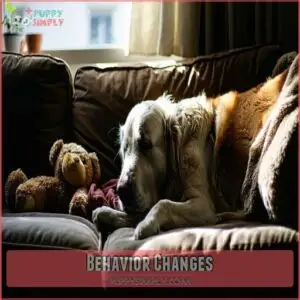This site is supported by our readers. We may earn a commission, at no cost to you, if you purchase through links.

Lethargy often sets in, and even the once lively pup might prefer resting in quiet corners or sticking close to you. Some dogs isolate themselves, while others become unusually clingy.
You might also see restlessness, confusion, or a loss of coordination, like clumsiness or trouble walking. Though it’s tough to witness, these signs help you understand their needs and bring them comfort in their final moments.
Table Of Contents
- Key Takeaways
- Signs Your Dog Might Be Dying
- Signs a Dog May Be Dying
- End-of-Life Care: How to Make Your Dog’s Last Days Comfortable
- How Do I Know It is Time?
- You Have Options When It’s Time to Say Goodbye
- Grieving The Loss of Your Dog
- What to Do When Your Dog Dies?
- Frequently Asked Questions (FAQs)
- What is a common dog behaviour before death?
- What are the signs when a dog is dying?
- Do dogs know they are dying?
- Do dogs have a sense of death?
- Should you observe old dog behavior before death?
- How do you know if a dog is in end of life?
- What happens hours before a dog dies?
- How do you tell if a dog is in its last days?
- How do I know if my old dog is suffering?
- How do you know when your dog no longer has quality of life?
- Conclusion
Key Takeaways
- You’ll notice dramatic behavioral shifts in your dying dog, including extreme lethargy, appetite loss, and social withdrawal. These changes aren’t random but signal your pet’s declining health and approaching end of life.
- Your dog’s physical abilities will deteriorate, with decreased mobility, poor coordination, and potential confusion becoming more pronounced. They’ll struggle to move, interact, or maintain their previous energy levels.
- Your companion may display contradictory behaviors—either becoming unusually clingy or seeking isolation—as they navigate their final stages. These emotional and social changes reflect their internal struggle and changing physical condition.
- You’ll need to focus on providing comfort, pain management, and compassionate care during this difficult time. Understanding these behavioral signs helps you support your dog’s quality of life and make informed decisions about their end-of-life journey.
Signs Your Dog Might Be Dying
It’s hard to watch your dog show signs of slowing down or acting differently, but these changes can help you understand what’s happening.
Noticing a lack of appetite, lethargy, or unusual behavior could mean your dog is nearing the end of their journey.
Lack of Appetite
A sudden loss of appetite can be one of the clearest signs a dog is nearing the end, and it’s heartbreaking to watch. That once-excitable tail wagging at dinnertime fades as food aversion creeps in. Loss of appetite may stem from worsening health, digestive issues, or medications. Understanding dog drinking before death is also essential as it can indicate declining health.
To support their nutritional needs during this stage:
- Offer softer, easy-to-digest foods like plain chicken, broth, or rice that are gentle on the stomach.
- Serve smaller portions more frequently to reduce stress during meals.
- Warm their food slightly to enhance aromas and encourage eating.
Always monitor water intake alongside eating habits to prevent dehydration. Their appetite loss isn’t about being picky—it’s part of these difficult dog dying symptoms.
Extreme Weight Loss
Extreme weight loss is one of the more visible signs of a dog’s health decline.
You may notice rapid weight loss, muscle wasting, and visible ribs, even if your dog has always been a little on the sturdy side.
Loss of appetite worsens the situation as their body struggles to maintain strength.
This drastic change often leads to body weakness and a lack of energy for daily activities.
Consult your vet for options, but understand this may be a signal of their final chapter.
Dehydration or Not Drinking Water
When a dog’s water intake drops, dehydration signs like a dry mouth, dull eyes, and labored breathing can show they’re in a serious health decline.
Fluid loss at this stage could cause an electrolyte imbalance, leading to dog behavior changes before death, like restlessness or unusual passiveness.
To help, try adding water to their food or use a syringe if needed, supporting your dog during their end-of-life journey and providing comfort in their final moments.
Lethargy
Lethargy is one of the clearest dog death symptoms that shows your pup’s fading energy levels. You’ll notice disrupted sleep patterns with longer naps and limited interaction. Simple activities may seem too tiring. Support your pet by offering cozy rest modes, like favorite blankets or beds close by.
Muscle weakness can surface, leading to clumsiness or accidents. Utilizing calming dog aids can help reduce stress.
Try these calming techniques:
- Gently pet them during rest.
- Keep their space distraction-free.
- Offer soothing words or reassurance.
Isolation or Becoming Extra Needy
Does your dog seem unusually distant or desperate for attention? These changes in behavior aren’t random. Social withdrawal, such as hiding in quiet spots or avoiding family, might reflect physical changes or emotional distress.
On the flip side, clingy dogs may crave constant reassurance, displaying needy behavior or following you everywhere. Both extremes are normal parts of dying dog behavior.
Restlessness, altered sleep, and even separation anxiety can emerge as they near the end. For more information on old dog behavior, recognizing the signs is vital.
Offer gentle comfort and remember: your companionship is their anchor during this tender, emotional phase in their canine end-of-life journey.
Signs a Dog May Be Dying
When your dog is nearing the end of their life, their behavior and physical abilities may change dramatically.
You might notice signs like extreme fatigue, confusion, or trouble moving, which can be heartbreaking but also offer insight into their needs.
Lethargy and Fatigue
When your dog starts losing interest in their usual activities and spends most of their time napping or lying down, it’s a clear sign their energy levels are waning. This isn’t your pup simply enjoying some extra rest modes—it’s one of the fatigue signs that often accompany a dog near death.
You might notice subtle shifts in sleep patterns, like sleeping more during the day or seeming too tired to respond to you. Their once lively spark fades as exhaustion stages set in. Considering dog fatigue supplements can be essential in such situations.
At this point, offering comfort and care becomes key, knowing these changes in dog behavior before death are natural but deeply emotional.
Poor Coordination
Stumbling issues and balance problems are common signs of coordination loss in a dog’s final days. As muscle weakness sets in, your pup might struggle to navigate even familiar spaces like hallways or their favorite spot by the couch. This mobility decline is part of the natural aging process. Understanding dog drinking before death can also provide valuable insights into your pet’s condition.
Here’s how to help:
- Lay down non-slip mats to prevent falls.
- Create a cozy space nearby so they don’t need to move far.
- Use a harness or sling to steady them when walking.
Decreased Mobility
Limited movement can make your old dog’s world feel smaller. Decreased mobility often stems from muscle atrophy or joint pain.
Here’s how to help:
- Mobility aids: Try harnesses or ramps to ease movement.
- Physical therapy: Gentle exercises like walking or light massage improve circulation.
- Comfort: Soft bedding supports stiff joints, reducing discomfort.
- Vet-approved pain relief: Medications or supplements can address joint pain.
- Mental stimulation: Puzzle toys or scent games keep them engaged when physical play declines.
Support makes this stage easier for everyone.
Confusion
As your dog nears the end, you might notice disorientation signs like pacing aimlessly or forgetting familiar faces and places.
Memory loss and spatial awareness issues can make them seem lost, even in your home. This mental decline often resembles canine cognitive dysfunction or dog dementia, leaving them confused and anxious.
They may vocalize unexpectedly or seem distant, withdrawn from interaction. These changes in dog behavior before death are heartbreaking, but they reflect natural declines as their body and mind slow down.
Behavior Changes
Your dog’s behavior might feel unfamiliar as they near the end. It’s normal to notice dog behavior changes, like social withdrawal—they may prefer quiet corners over your company. On the flip side, some dogs become extra needy, craving your presence more than ever.
Behavioral changes often include mood swings, subtle anxiety issues, or even vocalization changes, like whining or barking for no apparent reason. Restlessness signs, such as pacing or trouble settling, are another clue their body is struggling to find comfort.
You may observe:
- Social withdrawal: Isolating themselves or seeking unusual hiding spots.
- Restlessness and pacing: Signs of discomfort or unease.
- Mood swings: Shifting between clingy affection and aloofness.
- Vocalization changes: Increased whining, groaning, or barking.
These canine behavior shifts are a heartbreaking but natural part of their decline. Patience will help you support them.
End-of-Life Care: How to Make Your Dog’s Last Days Comfortable
Caring for your dog in their final moments is all about offering peace and love. Focus on the following:
- Create Comfort: Use soft beds, cozy blankets, and familiar items. Keep the space quiet and temperature-controlled.
- Pain Management: Partner with your vet for customized hospice care, including medication and mobility aids.
- Show Love: Sit with them, pet gently, and talk soothingly. Your calm presence matters.
- Quality Life Decisions: If their condition worsens, consider euthanasia to guarantee dignity during the canine dying process.
How Do I Know It is Time?
When the dog dying process becomes evident, figuring out the right moment can be heartbreaking. Watch for pet dying signs like chronic pain, refusal to eat, or extreme lethargy. Assess their life quality—are the bad days outnumbering the good? Symptom tracking is key to understanding the canine dying process.
Consult your vet about care options or dog euthanasia signs. Understanding dog euthanasia procedures can also help you make informed decisions.
- Pain assessment: Is your dog showing difficulty moving or sleeping?
- Life quality: Appetite, joy, and mobility matter.
- Final moments: Let professionals guide you compassionately.
You Have Options When It’s Time to Say Goodbye
Deciding how to say goodbye is never easy, but you’ve got options to guarantee quality care for your dog’s final moments. Whether it’s the euthanasia process or pet hospice, the focus should always be on comfort and dignity.
If your dog dies at home, checking the veterinary services can provide guidance on the next steps.
| Option | Description | Benefit | Considerations |
|---|---|---|---|
| Euthanasia Process | Peaceful, painless medical goodbye | Ends suffering quickly | Can be emotionally difficult |
| Pet Hospice | Comfort-focused care at home | Maintains familiar surroundings | May prolong dog behavior decline |
| Memorial Services | Personalized farewells | Honors your dog’s life | Costs vary by type chosen |
| Home Burial | Private, personal goodbye | Creates a tangible resting place | Check local laws |
Choose what feels right for you and your beloved companion.
Grieving The Loss of Your Dog
Saying goodbye to your dog is heart-wrenching, leaving you with a void only they could fill. Grief is messy, and the mourning process doesn’t follow rules. Some days, memories of your loyal companion may bring comfort, while other times, tears.
Finding pet grief support—whether through friends, dog grief support groups, or pet bereavement counseling—can help. Talking to others who’ve faced pet loss grief reminds you that you’re not alone.
Creating a pet memorialization, like a framed paw print or a memory box, is a meaningful way to honor their life.
Understanding end of life care is essential for dog owners.
Emotional healing takes time, so don’t rush it. Your bond with them was unmatched, and honoring it, in your own way, is a step toward coping with pet loss.
What to Do When Your Dog Dies?
Losing your dog is heartbreaking, but knowing what to do next can bring some peace. Start with aftercare arrangements, like choosing cremation or burial in a pet cemetery. If you’re unsure, a vet can guide you through body care options.
Understanding dog drinking before death can also provide valuable insights into your pet’s final moments. Memorializing pets—through photo albums or planting a garden—helps keep their memory close.
Lean on grief support resources, such as a pet loss group or therapist, to navigate the pain. Healing takes time, so give yourself grace and patience.
Frequently Asked Questions (FAQs)
What is a common dog behaviour before death?
Your aging dog might withdraw, become extremely lethargic, and lose interest in food, people, and favorite activities.
They’ll sleep more, seem restless, and may seek quiet, isolated spaces as their health declines.
What are the signs when a dog is dying?
When the chips are down, watch for key signs your dog’s nearing the end:
extreme lethargy, loss of appetite, incontinence, withdrawal from family, labored breathing, and decreased interest in once-loved activities.
Do dogs know they are dying?
Dogs likely sense their declining health through instinctive awareness, showing changes in behavior and interaction.
While they may not comprehend death intellectually, they experience physical and emotional shifts signaling their body’s gradual shutdown, through emotional shifts.
Do dogs have a sense of death?
It’s like dogs have a sixth sense—they seem to pick up on changes around and within themselves.
While they mightn’t fully grasp death, they sense shifts in energy, emotions, and their own condition.
Should you observe old dog behavior before death?
Yes, observe your aging dog closely.
Look for changes in behavior, appetite, mobility, and energy levels.
Track these signs to understand their health and quality of life, helping you provide compassionate care during their final stages.
How do you know if a dog is in end of life?
Ironically, your loyal companion’s final whispers aren’t always loud.
Watch for dramatic shifts: extreme lethargy, disinterest in favorite things, appetite loss, breathing changes, and withdrawal.
These subtle signs scream volumes about your dog’s end-of-life journey, with dramatic shifts being key indicators.
What happens hours before a dog dies?
In the final hours, you’ll notice your dog becoming extremely lethargic, struggling to breathe, losing bladder control, and showing little interest in surroundings.
Their body will feel cold, and they’ll seek quiet, isolated spaces as life slips away, a time when they will be struggling.
How do you tell if a dog is in its last days?
Like a dimming light, your aging companion shows telltale signs of decline.
Watch for extreme lethargy, loss of appetite, incontinence, isolation, and lack of interest in once-beloved activities—subtle whispers of your dog’s final journey.
How do I know if my old dog is suffering?
Watch for signs like extreme lethargy, loss of appetite, withdrawal from family, and visible discomfort.
Your dog’s behavior changes might signal suffering.
Consult your vet to assess their quality of life and explore compassionate care options.
How do you know when your dog no longer has quality of life?
When your dog’s daily struggles outweigh joy, you’ll notice a profound shift.
Inability to enjoy favorite activities, constant pain, and significant mobility issues signal it’s time to compassionately evaluate their quality of life with your veterinarian.
Conclusion
Sadly, saying goodbye to your furry friend is never easy.
Understanding dog behavior before death helps you provide compassionate end-of-life care, ensuring your pet’s final moments are filled with love and comfort.
Remember, each dog’s journey is unique, and by recognizing these signs, you’ll be better prepared to support your loyal companion through this difficult passage.
Your presence and tenderness matter most during these precious, heartbreaking moments.
- https://societyforpsychotherapy.org/traumatic-pet-loss/
- https://www.leesvilleanimalhospital.com/blog/2016/june/how-do-i-know-when-my-dog-is-dying-/
- https://vethelpdirect.com/vetblog/2021/09/09/is-it-kindest-just-to-let-dogs-pass-away-naturally/
- https://www.psychologytoday.com/gb/blog/animal-emotions/202308/do-dogs-understand-when-theyre-dying
- https://www.lovetoknow.com/life/lifestyle/warning-signs-a-dog-is-dying
















